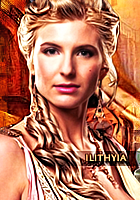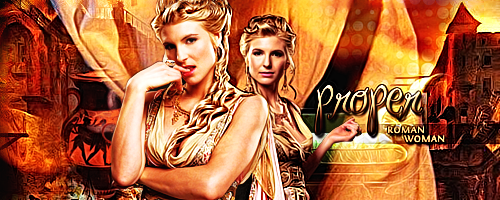Post by Ilithyia on Apr 5, 2011 8:37:08 GMT -6
Roman society is ultimately based on wealth and family. At rock bottom are those with nothing: the men and women who don’t even own themselves. They are the slaves, the engines that drive the Roman world, often treated like a disposable resource constantly replenished through conquest. Above them is freed slaves (freedmen), then freeborn Roman citizens, and at the top is a two-tiered aristocracy of equestrians and senators.
the familia
Romans belong to a family (familia) under the authority of the family head, or pater familias. The family includes more than blood relations: It includes slaves, freedmen, all household members, and property – the entire extended family and household system. Though relatives might move into their own households, they remain connected under the authority of the pater familias as if they were still under one roof.
All members of the familia, regardless of age or where they live, are subject to his patria potestas, or paternal power. The pater is judge, jury, priest, and autocrat. He can punish, execute, or otherwise dispose of any person or material belonging of his familia at his judgment and discretion. Other members or property brought in by marriage, adoption, purchase or conquests are under his protestas, as well. He is the only individual in the entire extended structure of the familia who has independent and individual status before law and the state.
citizen class distinction
Roman society is made up mostly of free citizens, but there is a core group of aristocratic families. The distinction between the general free population and the aristocrats is defined by wealth founded on land and divided into orders known as the plebeians (the majority) and the patricians (the aristocrats).
Because patricians control Roman society, the rest of the population is completely dependent upon them, working as laborers or tenants on their land. Out of this develops the patron-client relationship:
Although some plebs grow wealthy and join the ranks of the aristocracy as senators or equestrians, the vast majority of the Roman population is just ordinary citizens. These people lead hard, short and dangerous lives in a world where protective health and safety legislation are none-existent. But it is also these people that the nobles entertain in the circus and arena. The nobles might look down on the Roman mob, but they know they can not survive without them.
slavery
Slaves come from a variety of sources. People can fall into debt and eventually be sold into slavery. Infants and children who are unwanted or cannot be cared for by their families are also sold as slaves. Conquered and kidnapped peoples are a major source of slavery for the Republic.
As one can expect, slaves have no status, legal or otherwise. Their bodies and their children are the property of their masters. There is no protection from being arbitrarily killed by their masters or from being forcibly castrated for profit. The draconian law of killing every slave (men, women, and children) owned by a master if he is murdered by one of them is enforced.
Some slaves do have it better than others though, depending upon their relationship with their owner. The better a relationship between owner and slave, the more likely a slave is to receive decent treatment and gain freedom. The slaves who have it worse are those that work in the mines. Such slaves are considered no better than interchangeable parts to be worked to death and replaced. These conditions are usually found on the large plantations and in the gladiator schools were slaves are trained to kill or be killed for entertainment.
the familia
Romans belong to a family (familia) under the authority of the family head, or pater familias. The family includes more than blood relations: It includes slaves, freedmen, all household members, and property – the entire extended family and household system. Though relatives might move into their own households, they remain connected under the authority of the pater familias as if they were still under one roof.
All members of the familia, regardless of age or where they live, are subject to his patria potestas, or paternal power. The pater is judge, jury, priest, and autocrat. He can punish, execute, or otherwise dispose of any person or material belonging of his familia at his judgment and discretion. Other members or property brought in by marriage, adoption, purchase or conquests are under his protestas, as well. He is the only individual in the entire extended structure of the familia who has independent and individual status before law and the state.
citizen class distinction
Roman society is made up mostly of free citizens, but there is a core group of aristocratic families. The distinction between the general free population and the aristocrats is defined by wealth founded on land and divided into orders known as the plebeians (the majority) and the patricians (the aristocrats).
Because patricians control Roman society, the rest of the population is completely dependent upon them, working as laborers or tenants on their land. Out of this develops the patron-client relationship:
- The patron acts like a father figure to his clients, who are often his freedmen (former slaves): He takes a personal interst in their careers, financial concerns, and any legal or business problems.
- The client has a duty of loyalty to his patron, which means helping with money if his patron is in public office, has been fined, captured in war and held for ransom, and generally offering his support.
Although some plebs grow wealthy and join the ranks of the aristocracy as senators or equestrians, the vast majority of the Roman population is just ordinary citizens. These people lead hard, short and dangerous lives in a world where protective health and safety legislation are none-existent. But it is also these people that the nobles entertain in the circus and arena. The nobles might look down on the Roman mob, but they know they can not survive without them.
slavery
Slaves come from a variety of sources. People can fall into debt and eventually be sold into slavery. Infants and children who are unwanted or cannot be cared for by their families are also sold as slaves. Conquered and kidnapped peoples are a major source of slavery for the Republic.
As one can expect, slaves have no status, legal or otherwise. Their bodies and their children are the property of their masters. There is no protection from being arbitrarily killed by their masters or from being forcibly castrated for profit. The draconian law of killing every slave (men, women, and children) owned by a master if he is murdered by one of them is enforced.
Some slaves do have it better than others though, depending upon their relationship with their owner. The better a relationship between owner and slave, the more likely a slave is to receive decent treatment and gain freedom. The slaves who have it worse are those that work in the mines. Such slaves are considered no better than interchangeable parts to be worked to death and replaced. These conditions are usually found on the large plantations and in the gladiator schools were slaves are trained to kill or be killed for entertainment.


